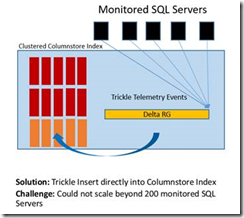Clustered Columnstore Index: Massively Parallel Trickle Insert
A traditional scenario of loading data into CCI is a nightly load from one or more data files containing millions of rows. Recommended technique is to load the data with batchsize >= 102400 as explained here https://blogs.msdn.microsoft.com/sqlserverstorageengine/2014/07/27/clustered-column-store-index-bulk-loading-the-data/. However, we are seeing many scenarios where data source is parallel data stream (i.e. trickle insert) to be loaded into CCI for analytics, a typical IOT scenario. CCI allows concurrent data streams into the same delta rowgroup. However, you will see higher page latch contention as you increase the concurrency. You may wonder why this is so? Well, each delta RG is organized internally as a clustered btree index and the dataload follows the pattern of monotonically increasing clustered index key causing latch contention on the last page. Here is a simple way to test the ‘hidden’ key values inserted into a CCI
create table foo (c1 int)
create clustered columnstore index foocci on foo
go
insert into foo values (1)
insert into foo values (2)
-- check the hidden clustering key index
select %%physloc%% , * from foo
Here is the output
Note, the values encircled above represents a hidden rowstore clustered index key column representing (<rowgroup-id>, <tuple-id>). <tuple-id> is internally generated in a monotonically increasing number resulting in page latch contention on concurrent insert. In fact, we have seen this with many of our customers as shown in the picture below. The scenario here is collect telemetry data from applications (in this case SQL Servers) and load it into a table with CCI for analytics. In the example, below, the delta RG could not scale beyond a certain number of data sources, in this example 200. The actual number will vary with your workload.
You can remove this data loading by staging the data into a non-durable/durable memory optimized table as shown below. Note, the memory optimized table, native to SQL Server Engine, are implemented to keep data in memory without the PAGE structure thereby eliminating last page contention.
With this change, the customer was able to completely by pass the delta rowgroup using a background thread that migrates the rows from memory-optimized table in chunks larger than 102400.
Thanks
Sunil Agarwal


